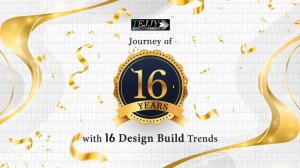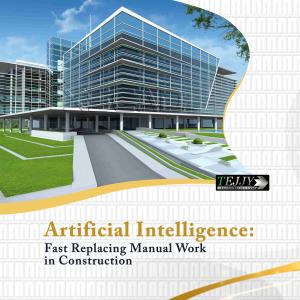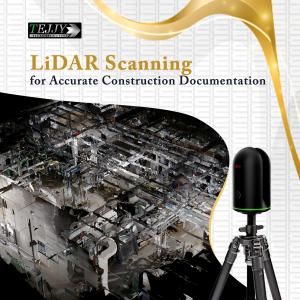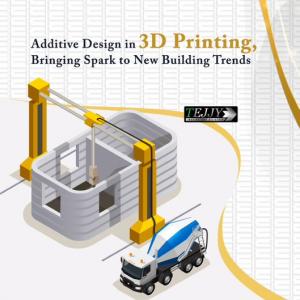Journey of 16 years with 16 Design Build Trends
Future of building design depends to a great extent on successful implementation of innovative technologies. Tejjy makes a move with 16 emerging tech trends.
We are commemorating our 16th year as a BIM Engineering Company in the United States this month.”
WASHINGTON DC, DISTRICT OF COLUMBIA , USA, May 4, 2022 /EINPresswire.com/ -- Many have the notion that the construction sector is slow to adopt new techniques. The domain looks like a relic of the past, consigned to the archives along with blueprint paper and L-squares. There's no doubt that sectors like space, renewable energy and transportation are leading in terms of implementation of the technology. However, the AEC industry is not lagging. So, here the notion proves to be a misconception. The construction industry has changed dramatically over the past two decades, paving the stage for a future of digital transformation. — Sukh Singh
Collaborative modern design technology has become increasingly popular in architectural projects with an emphasis on green infrastructure and energy efficiency. Innovations in technology have accelerated at an incredible pace and AEC is surely not an exception in this regard. Tech trends like Building Information Modeling, Virtual Reality, AR and robotics have the potential to transform the working practices of architectural design. The future of building design depends to a great extent on the successful implementation of innovative design technologies. Well, this should not be equated with colonizing Mars or building human space stations, but this would secure the future or design-built environment on Earth.
16 Emerging Trends in Building Design:
The upcoming trends in modern tech design are urging AEC professionals to provide the best services in the techno-equipped surrounding. New applications and new technology in construction 2020 & 2021 have made tasks easier for architects, allowing them to thrive with the project challenges. Starting from site study to final virtual experience at pre-construction, everything is getting possible with technology implementation. Sam100 and Hydrian X – the mechanical bricklaying robots are now programmed for modifying brick laying patterns and layouts. These robots have great efficiency compared to manual labor. Finch 3D is another software application, launched as a plug into Rhino/Grasshopper for leveraging designs during the starting phases of construction. Archicad, Revit, Fuzor, Jaunt VR, etc. are the other software platforms and technological tools that gear up the AEC professionals for an integrated workflow of the future.
Tejjy Making a Move with 16 Trends in Building Design & Construction:
“We are commemorating our 16th year as a BIM Engineering Company in the United States this month." Sukh Singh, the Vice President of Tejjy Inc. stated.
Connected BIM: BIM has already set new heights, enabling the perfect distribution of work through different stages of construction. Consequently, there is proper execution of work with lesser inaccuracies. The technique helps engineers, architects, estimators, clients and others to collaborate and work in a single shared process. BIM software applications like Revit, ArchiCAD, Allplan, etc. are all in use. However, through Connected BIM, AEC professionals can reduce operational costs through continuous analysis of the building's utility system.
Artificial intelligence: AI is fast replacing manual work and enhancing optimization by considering weather and site conditions to experience virtual walkways. Automation, robots and the internet of things are creating building design with improved efficiency, working wonders in future.
Big Data: Big data has created waves in architecture. Today, architects are crafting building designs that can store big data servers and warehouses. Data is becoming more widely available, and the Internet of Things is assisting architects in accessing data for design and construction.
LiDAR: LiDAR scanning is also an invaluable tool for accurate construction documentation and representation of the building interiors in vivid digital detail. Owing to its efficiency, speed and accuracy, it has become significant in its use within architecture, construction and design.
Humanoid Laborers: Humanoid laborer is a completely autonomous robot with human-like features that helps to reduce the labor shortage plaguing the construction sector. Like all service robots, they provide value to architectural services by automating tasks, leading to cost savings and improved productivity.
Robotics: The purpose of robotics is to create intelligent machines to assist humans in a variety of ways. Architects use robotics for building habitable structures in areas that would usually be unsuitable for human life, like oceans or deserts. Robots help to build all structures that humans need to survive in these environments long before the arrival of the first occupants.
Drones: Drones are transforming completely the way construction firms work. Data collected by drones help to eliminate the need for appointing land surveyors for creating topographic surveys.
Additive Design in 3D Printing: Additive design encompasses human as well as artificial intelligence in making a building design efficient. 3D printing facilitates model creation of the whole structure. Few countries have already adopted the technology and it has brought a spark to the new building design trends of the coming years.
Advanced Version of Software Applications: Applications like Revit, Grasshopper, and Rhino are being implemented by architectural firms across the globe. Further, there is no dearth of advanced versions of the existing ones and the launching of newer one leads to increased time saving and organized project workflow.
Virtual Reality: VR helps construction professionals to explain their ideas and concepts to clients in real-life experience. VR technology is one of the tech trends popular amongst AEC clients and designer groups, creating efficient and user-specific designs. Take a look at the future of BIM & VDC from this blog.
Augmented Reality: AR adds value to the practical experience by overlaying 2D over 3D. The technology adds 3D sound and tactile effects to a 2D layout, giving users the impression that the materials are being incorporated into the design.
Mixed Reality: Mixed Reality enables interaction between physical and virtual spaces, giving rise to concepts like vertical cities owing to rapid urbanization and the dearth of spaces. Nevertheless, this technology lies at the initial stage of exploration and experimentation for being used widely as a tool for architectural and engineering services.
Parametric Architecture: Another area is parametric design - a generative design system, where adjusting parameters help to compute and build a variety of outputs, forms and structures. The parametric architecture employs a geometric programming language internally to be used directly by coding. Architectural service providers design parametrically using a software extension of Rhino called Grasshopper and make the same operation visually through a User Interface. Grasshopper helps to show the shape of the building and define handles for controlling it. Here, the computer and human imagination play together in designing architecture. Since it’s the code behind the shape, everything can be created with the code. AEC professionals can share the code, fork it and make libraries. Know more about Revit Family Creation.
Internet of Spaces: The ‘collaborative consumption’ or ‘sharing economy’ leads to a great impact on the housing and real estate sector. Peer-to-peer online platforms such as Airbnb, along with shared workspaces and driverless cars are leading towards a future, where infrastructure happens to be the key to the built environment. In residential architecture, interconnectivity and smart design would redefine the way of living space creation. Transformable spaces adapting to the homeowner’s age, economic status and personal preference are well on their way to becoming mainstream.
Smart Cities: With the growth of population, resources are becoming scarcer. Smart cities have become a prime facet of material and resource consumption. Integrated with big data and the IoT, the cities of the future would become more interconnected. Millions of sensors are already in place to monitor various things in a metropolis. In the recent future, these sensors will multiply till they can successfully monitor everything starting from streetlights, trashcans, and road conditions to energy consumption.
Modular & Offsite Construction: Prefabrication and modularization aren’t slowing down. The residential sector is projected to grow to about $110 billion by 2025, by a dearth of expert labor and cost-cutting techniques. Many international builders have plans to decrease on-site construction activity to 25% by 2025 through prefab construction. With modular projects, employee safety in climate-controlled and ventilated environments can be regulated, making them ideal for social distancing practice.
Holistic Building Design Approach in Mainstream Construction:
Working with the rising trends would help AEC professionals to make efficient use of resources, reduce energy consumption, and build smart cities with maximized efficiency. Big data helps Tejjy Inc. to understand how people in a city move, how energy is used and other aspects of infrastructure interaction. To provide people with a safe, comfortable, and affordable place to live, architects must collaborate with the latest technologies to create a holistic design to prevail in mainstream architecture. To know more about emerging tech trends in design & construction, get in touch with one of the top design-build firms in USA. Schedule an appointment with BIM service experts at 202-465-4830 or info@tejjy.com for discussing your construction projects.
Check out the 10 Construction Trends for Staying Competitive.
sukhchain singh
Tejjy Inc.
+1 240-595-4210
email us here
Visit us on social media:
Facebook
Twitter
LinkedIn
Other
New Emerging Trends in Architectural Design - A Promise to Sustainability | Tejjy Inc.





